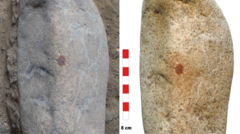In a remarkable archaeological find, scientists in Spain have unveiled what they believe to be the oldest complete human fingerprint, suggesting that Neanderthals were capable of creating art as early as 43,000 years ago. This discovery emerged from excavations at the San Lázaro rock shelter in Segovia, where researchers found a pebble that strikingly resembled a human face, adorned with a red dot interpreted as paint.
The research indicates that a Neanderthal individual likely dipped their finger in red pigment, possibly ochre, to craft a nose-like feature on the pebble. This peculiar artifact has sparked discussions regarding the symbolic behaviors of Neanderthals, with study co-author María de Andrés-Herrero emphasizing its implications for understanding their cognitive capabilities.
The excavation at this site began five years ago, and last year researchers uncovered the pebble beneath a layer of sediments used by Neanderthal groups. Initially, the team was astonished by the find due to the larger-than-usual size of the stone compared to others at the site, which gave it a more distinct appearance.
After detailed analysis involving multi-spectral techniques, scientists confirmed the presence of a fingerprint, believed to belong to a male adult. However, co-author David Álvarez Alonso pointed out challenges in conclusively identifying the fingerprint as Neanderthal due to a lack of comparative references.
During a recent news conference, Spanish official Gonzalo Santonja described the pebble as the oldest known painted portable object in Europe, affirming its significance in the narrative of Neanderthal artistry. Prof de Andrés-Herrero stressed that this discovery is vital for furthering our comprehension of Neanderthal symbolic expression. The findings indicate that this red ochre dot was not just an accidental mark; it suggested intention behind its creation.
Moreover, it is striking that the red pigment is not typically found naturally within the shelter, indicating that one of the Neanderthal inhabitants intentionally brought it along. The research team posits that the striking fissures of the stone caught the attention of a Neanderthal, leading to the deliberate artistry witnessed in the dot later preserved through time.
The conclusions drawn from this research, published in the journal Archaeological and Anthropological Sciences, describe the pebble as remarkable, qualifying it as a visual symbol and a potential piece of portable art from an era that continues to reveal the complexities of human evolution and creativity.
The research indicates that a Neanderthal individual likely dipped their finger in red pigment, possibly ochre, to craft a nose-like feature on the pebble. This peculiar artifact has sparked discussions regarding the symbolic behaviors of Neanderthals, with study co-author María de Andrés-Herrero emphasizing its implications for understanding their cognitive capabilities.
The excavation at this site began five years ago, and last year researchers uncovered the pebble beneath a layer of sediments used by Neanderthal groups. Initially, the team was astonished by the find due to the larger-than-usual size of the stone compared to others at the site, which gave it a more distinct appearance.
After detailed analysis involving multi-spectral techniques, scientists confirmed the presence of a fingerprint, believed to belong to a male adult. However, co-author David Álvarez Alonso pointed out challenges in conclusively identifying the fingerprint as Neanderthal due to a lack of comparative references.
During a recent news conference, Spanish official Gonzalo Santonja described the pebble as the oldest known painted portable object in Europe, affirming its significance in the narrative of Neanderthal artistry. Prof de Andrés-Herrero stressed that this discovery is vital for furthering our comprehension of Neanderthal symbolic expression. The findings indicate that this red ochre dot was not just an accidental mark; it suggested intention behind its creation.
Moreover, it is striking that the red pigment is not typically found naturally within the shelter, indicating that one of the Neanderthal inhabitants intentionally brought it along. The research team posits that the striking fissures of the stone caught the attention of a Neanderthal, leading to the deliberate artistry witnessed in the dot later preserved through time.
The conclusions drawn from this research, published in the journal Archaeological and Anthropological Sciences, describe the pebble as remarkable, qualifying it as a visual symbol and a potential piece of portable art from an era that continues to reveal the complexities of human evolution and creativity.



















